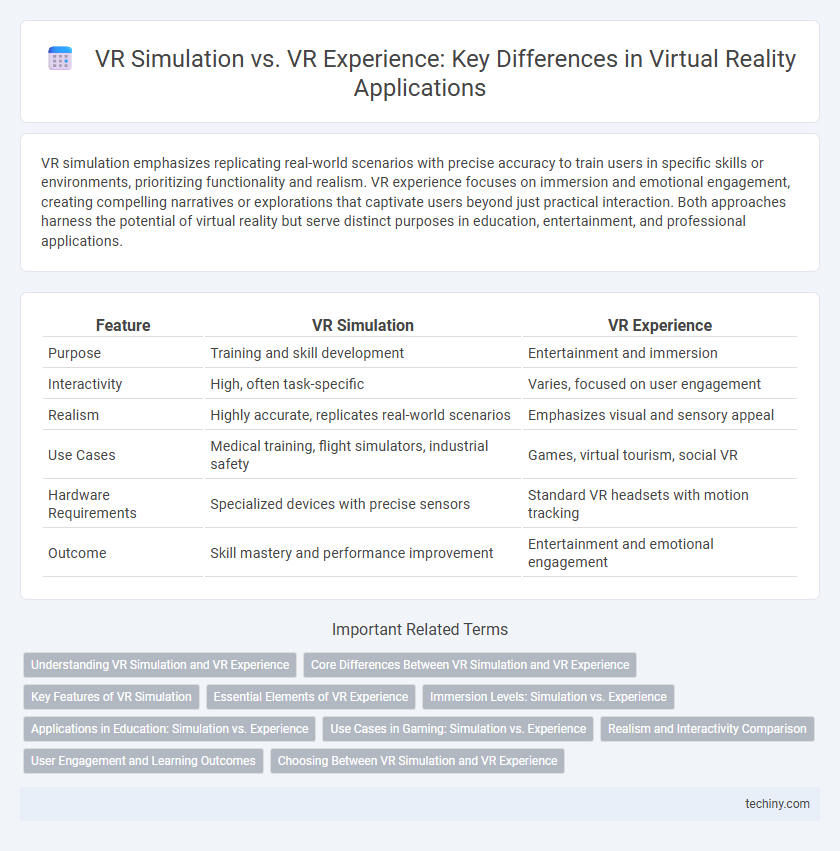VR simulation emphasizes replicating real-world scenarios with precise accuracy to train users in specific skills or environments, prioritizing functionality and realism. VR experience focuses on immersion and emotional engagement, creating compelling narratives or explorations that captivate users beyond just practical interaction. Both approaches harness the potential of virtual reality but serve distinct purposes in education, entertainment, and professional applications.
Table of Comparison
| Feature | VR Simulation | VR Experience |
|---|---|---|
| Purpose | Training and skill development | Entertainment and immersion |
| Interactivity | High, often task-specific | Varies, focused on user engagement |
| Realism | Highly accurate, replicates real-world scenarios | Emphasizes visual and sensory appeal |
| Use Cases | Medical training, flight simulators, industrial safety | Games, virtual tourism, social VR |
| Hardware Requirements | Specialized devices with precise sensors | Standard VR headsets with motion tracking |
| Outcome | Skill mastery and performance improvement | Entertainment and emotional engagement |
Understanding VR Simulation and VR Experience
VR simulation involves creating immersive, computer-generated environments that replicate real-world scenarios for training, education, or analysis purposes. VR experience emphasizes user interaction and emotional engagement within virtual spaces, often designed for entertainment or exploration. Understanding these distinctions helps optimize applications in industries such as healthcare, gaming, and military training.
Core Differences Between VR Simulation and VR Experience
VR simulation primarily focuses on replicating real-world scenarios with high accuracy for training, education, or analysis purposes, emphasizing precision and controlled environments. VR experience centers on immersion and user engagement, designed to provide entertainment, storytelling, or social interaction through sensory-rich and interactive elements. Key differences lie in the objectives, with simulations targeting functionality and data fidelity, while experiences prioritize emotional impact and user presence.
Key Features of VR Simulation
VR simulation emphasizes interactive environments designed for training and skill development by replicating real-world scenarios with high precision. Key features include real-time feedback, programmable scenarios, and multisensory integration, enhancing user engagement and learning outcomes. This contrasts with VR experience, which prioritizes immersive storytelling and entertainment through visually rich environments.
Essential Elements of VR Experience
VR simulation focuses on replicating real-world environments or scenarios through computer-generated graphics and interactive elements, emphasizing accuracy and functionality. VR experience centers on immersion, presence, and emotional engagement, leveraging sensory input, haptic feedback, and spatial audio to create a believable and compelling virtual world. Essential elements of VR experience include high-resolution visuals, low latency tracking, intuitive user interfaces, and multisensory integration to enhance realism and user engagement.
Immersion Levels: Simulation vs. Experience
VR simulation offers structured, high-fidelity environments designed to replicate real-world scenarios with precise sensory inputs, enhancing cognitive immersion for training and analysis. VR experience emphasizes emotional and narrative immersion through interactive storytelling and sensory engagement, often prioritizing user agency and presence over exact realism. Both approaches leverage varying immersion levels to optimize user engagement, where simulation targets accuracy and repeatability while experience fosters empathy and exploration.
Applications in Education: Simulation vs. Experience
VR simulation in education enables immersive, hands-on practice of complex skills such as medical procedures and engineering tasks, providing risk-free, repeatable training scenarios. VR experience emphasizes emotional engagement and contextual learning, enhancing empathy and retention through realistic environments like historical events or cultural explorations. Both approaches complement each other by combining practical skill development with deep experiential understanding for comprehensive educational outcomes.
Use Cases in Gaming: Simulation vs. Experience
VR simulation in gaming primarily focuses on replicating real-world activities, such as flight simulators or driving games, enabling players to practice skills and strategies in a controlled virtual environment. VR experience emphasizes immersive storytelling and emotional engagement, connecting players deeply with game narratives through interactive environments and sensory feedback. Both use cases leverage advanced graphics, motion tracking, and haptic devices to enhance realism, but simulations prioritize accuracy and training, while experiences prioritize entertainment and emotional impact.
Realism and Interactivity Comparison
VR simulation emphasizes precise realism by replicating physical environments and scenarios with detailed graphics and accurate physics, enhancing user training and skill development. VR experience prioritizes immersive interactivity, allowing users to engage naturally within virtual worlds through intuitive controls and sensory feedback, fostering emotional connection and exploration. Both approaches leverage advanced hardware such as haptic devices and motion tracking to balance realism and interactivity, tailored to their specific applications.
User Engagement and Learning Outcomes
VR simulation offers interactive, scenario-based training environments that enhance user engagement by allowing active participation and real-time feedback, leading to improved skill acquisition and retention. VR experiences prioritize immersive storytelling and sensory input, which boost emotional connection and contextual understanding but may vary in educational effectiveness depending on design. Balancing simulation's hands-on practice with experiential immersion maximizes learning outcomes through deeper cognitive involvement and motivation.
Choosing Between VR Simulation and VR Experience
Choosing between VR simulation and VR experience depends on the intended use case and user interaction level. VR simulations prioritize realistic, interactive environments for training, education, or professional applications, offering precise control and feedback. VR experiences focus on immersive storytelling and entertainment, emphasizing emotional engagement and sensory richness for users seeking enjoyment and exploration.
VR Simulation vs VR Experience Infographic

 techiny.com
techiny.com